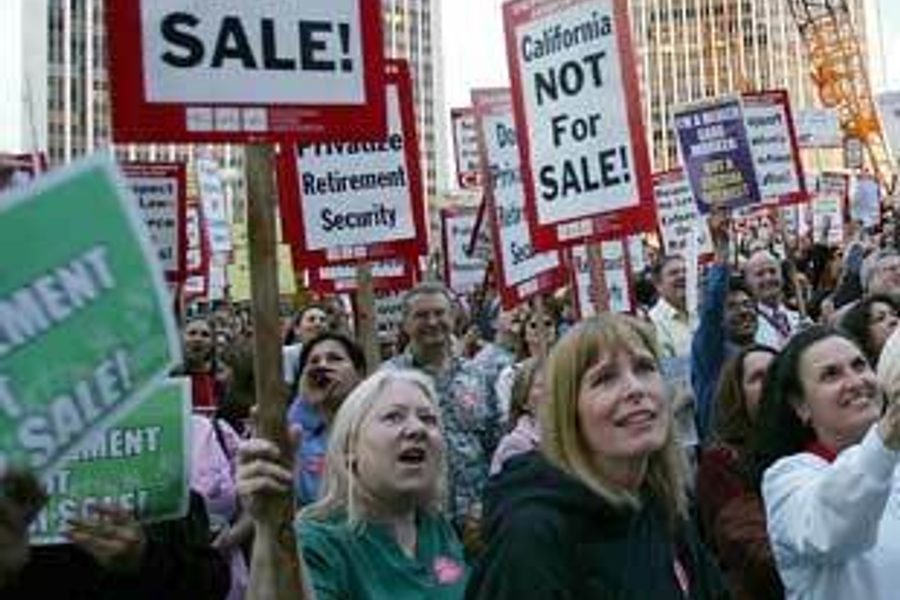Women’s Work
Female union members are gaining clout, but are still shut out of top labor positions
Kari Lydersen

The lingering stereotype of a union member may still be the burly Teamster or longshoreman. But increasingly the face of organized labor today is female. The service industry is the fastest growing unionized sector, and many of these janitors, food service workers and the like are women, many of them women of color. In 2002, women made up 42 percent of union members, according to the Bureau of Labor Statistics, compared to 19 percent in 1962.
However, union leadership has changed very little to reflect this. Out of 56 unions in the AFL-CIO, only two – the Screen Actors Guild and American Nurses Association – are headed by women. Women are equally unrepresented in other top union jobs, making up less than a fifth of top leadership. And the potential flight of major unions from the AFL-CIO probably will do little to change this; though the chair of the Change to Win coalition is a woman, its leadership is composed mostly of white males.
But while men have maintained a firm grip on official leadership positions in organized labor, women are gaining power and attention in different ways. A handful of vocal, female-dominated unions have become more daring, non-traditional and holistic in their approach to fighting for workers’ rights and in uniting union members with the general community.
“I think we’re seeing tremendous militancy among women workers both on the low-income end and among white collar women,” says Karen Nussbaum, assistant to the president of the AFL-CIO. “We’re well aware of the militant organizing tactics among janitors, the majority of whom are women. And hotel workers. The flight attendants have a campaign called CHAOS (Create Havoc Around Our System) where they wear lime green shirts objecting to working conditions. It’s a permanent part of their mobilization strategy.”
Nurturing with a vengeance
A prime example of a powerful women’s union is the California Nurses Association (CNA) and the National Nurses Organizing Committee (NNOC) that it spawned. The AFL-CIO lists the CNA as a “raider,” going after members of other nurses unions.
In fact, CNA has taken on none other than the greatest exemplar of machismo and power, California Gov. Arnold Schwarzenegger, in its tireless campaigns to raise nurse-patient ratios in California hospitals and to protect public workers’ pensions from privatization. The battle between Schwarzenegger and the nurses has become personal, with uniformed nurses denouncing the governor at Hollywood movie screenings, bodybuilding exhibitions and other public events.
CNA Executive Director Rose Ann DeMoro thinks that because the almost entirely female membership has experienced sexism and gender-based marginalization, they are unwilling to compromise or believe false promises in their fights for workers’ rights. “I think [male union leaders] see themselves as junior partners in corporations; their view of labor is to increase productivity and control costs,” says DeMoro. “Women, because of a different type of socialization and because we’ve been shut out for so long, don’t see it that way.”
The 58,000 member CNA broke from the American Nurses Association (ANA) in 1995 out of frustration at the union’s passivity. CNA’s national arm, the NNOC, has been organizing nurses around the country, and won a big victory in Chicago in May when 1,800 nurses at Cook County hospital voted to switch from the ANA-affiliated Illinois Nurses Association to the NNOC.
While the aggressive, vociferous CNA campaign defies stereotypes of women as passive and accommodating, the nurses take pride in their perhaps “traditional” role as caretakers of patients and their community. They emphasize that their commitment to providing quality care for patients is at the heart of the staffing ratios debate, and they see their main battle as being for decent working conditions, affordable housing, healthcare and other basic rights for everyone.
“We spend an enormous amount of time in political education, vis-a-vis the relationship of nurses to the public,” says DeMoro. “You can’t be a patient advocate without being a social advocate, because medicine takes place in a social context. The things that affect your life, your family and your community are jobs, adequate health insurance, pensions, standards of living. It comes down to those issues.”
That’s why the nurses have been vocal on a wide range of social justice topics.
“Part of our appeal is that we’re not just there for [patient-nurse] ratios, we want to change the entire face of healthcare delivery and the way people look at politics,” says CNA president Deborah Burger, a diabetes case manager at an HMO medical center in Santa Rosa, Ca. “At my facility, everybody has insurance and they’re still struggling with choices of ‘Do I take my pain pills or chemo drugs or do I pay for my rent and groceries?’ We look at the broader picture and see that we need universal healthcare.”
The taking-care-of business
Childcare and home care workers organized by the Service Employees International Union (SEIU) in the past few years take a similar approach, pointing out that their clients – children, elderly and disabled people, among society’s most vulnerable – are not well served if their caretakers don’t have decent pay, healthcare and training. SEIU added 49,000 child care workers, almost all of them women, to the rolls of organized labor this spring when the union organized home childcare workers in Illinois; similar campaigns have also been going on in other states. In the process of organizing home care workers in 10 states, SEIU banded together with community groups advocating for the disabled, seniors and people with HIV. This allowed them to address the effects of economic and social policies on the workers themselves as well as on the marginalized populations they serve.
“(The home care workers) often had their hours cancelled by whatever state program was running things,” says SEIU International executive vice president Mary Kay Henry. “The union was able to provide stability, create a match system between clients, employers and workers and provide access to training.”
Helena Worthen, a labor educator at the University of Illinois, notes that through creative and militant organizing tactics women are gaining power in the labor movement more quickly than their lack of representation at the top levels reflects. Worthen co-authored a recent study highlighting the importance of labor education for women union members and pinpointing specific challenges women face in moving up the labor leadership ladder.
“We really distinguish between leadership status and leadership as taking responsibility,” says Worthen. “We emphasize leadership as taking responsibility because gaining status means overcoming some very entrenched barriers, like undemocratic processes and plain old corruption, which there’s a lot of. A lot of our big unions really have barriers to moving up in the ranks.”
Women interviewed for the study, which was supported by the Regina V. Polk Scholarship Fund for Labor Leadership, frequently pointed to their home situations as barriers to involvement in union activities. Women said their time commitments as single mothers; caretakers for elders; or wives who end up with most of the housework made it hard to find time to advance in the union bureaucracy. Respondents also described sexism within their unions and a lack of respect from men. However, they also indicated an apparent generational difference and said younger men are more open to women’s leadership.
In many ways, women have always been pushing the envelope and creating ground-level gains that are capitalized on by male leaders. In the late 1800s and early 1900s women fought for better working conditions in the textile and garment industries. In the ’30s and ’40s secretaries, waitresses and other traditionally female workplaces organized en masse; as auto workers were doing effective sit-down strikes in the Detroit area, so were waitresses at Woolworth’s. In the ’60s almost a million largely female teachers unionized to become a militant part of the labor movement and part of the social struggle of the time.
“But all this is invisible,” says Nussbaum. “When people think about labor history they think about guys. Women don’t win a place at the table, even though you’ve had these waves of women organizing in which they’ve been incredibly militant and changed the nature of the workplace.”
Kari Lydersen is a Chicago-based journalist, author and assistant professor at Northwestern University, where she leads the investigative specialization at the Medill School of Journalism, Media, Integrated Marketing Communications. Her books include Mayor 1%: Rahm Emanuel and the Rise of Chicago’s 99%.








